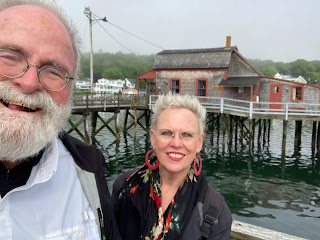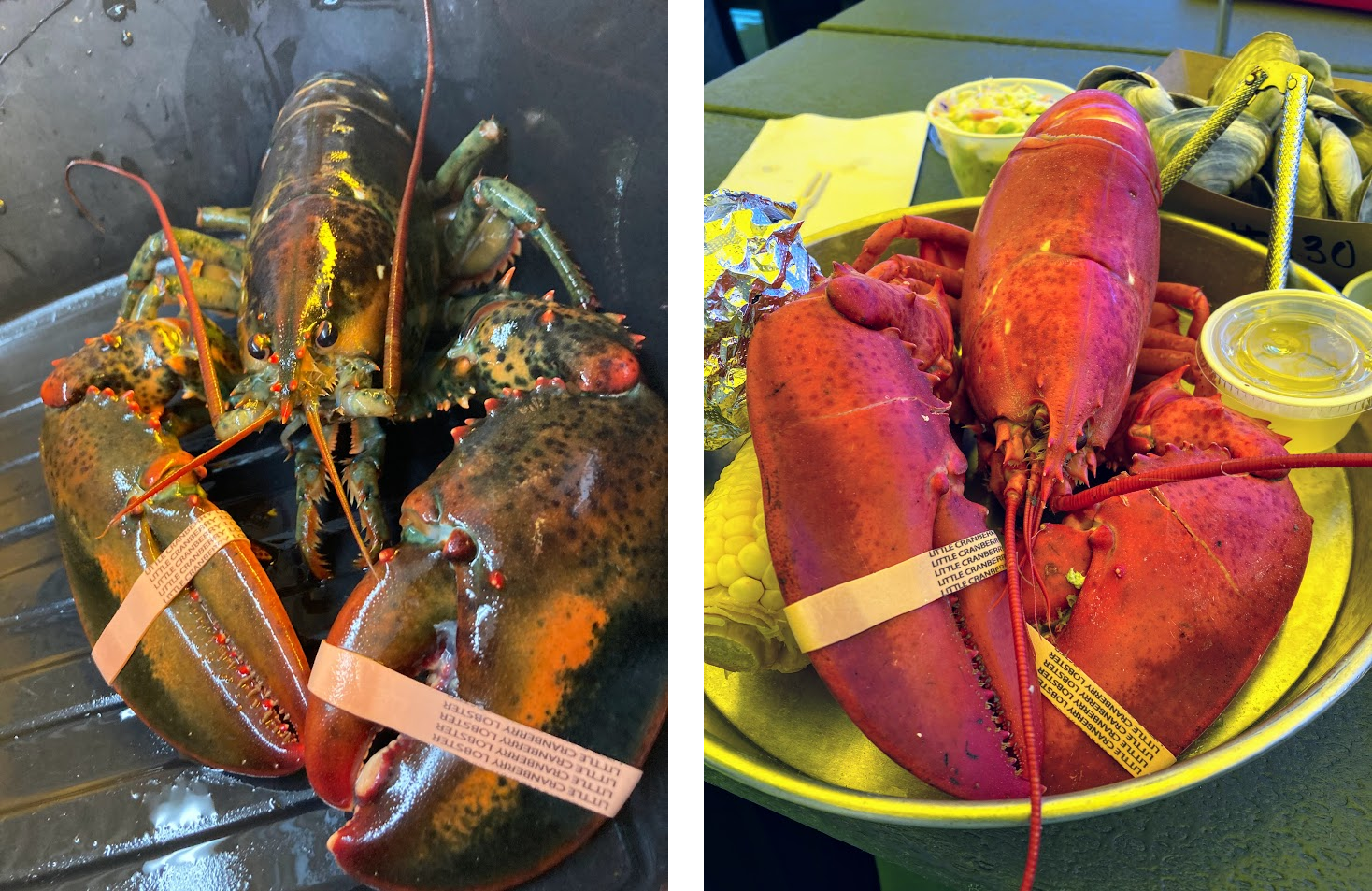On Monday morning we woke to partly-overcast skies. We had breakfast at our hotel (so-so) and drove off for our first stop, the Franconia Flume Gorge in New Hampshire's Franconia Notch State Park. Because it was a state (instead of a National) park, we had to pay an admission fee, but it was worth it. The trail through the gorge is two miles; a piece of cake for energetic youngsters like Kathy and I.
After a quarter mile (steeply down hill), we came to the Flume Covered Bridge. Built in 1886, and restored several times since, it is one of the oldest in the state. This bridge was built across the scenic Pemigewasset River, which means “swift or rapid current” in the Abenaki Indian language. We paused at the bridge to let a large group of older Mennonite couples go past us. (And also, so I could catch my breath.)
Past the bridge, the river falls over an exposed, large outcropping of Conway granite, called Table Rock. The rock is 500 feet long and 75 feet wide. Apparently inner-tubes are not allowed, but that was all I could think of.
After Table Rock, the gorge narrows and the sides began to rise steeply. To allow visitors to traverse the Flume, the Park Service has constructed an elaborate series of boardwalks, which are removed each winter, so they won't be destroyed by ice falling from the sides of the flume.
The Flume Gorge starts out deceptively easy, but rapidly gets steeper and narrower.
Along the sides of the Flume, trees, ferns, and plants grow out of the sheer sides of the granite and basalt walls.
The sides of the gorge are stunning. I think my iPhone pictures look pretty good, but I can imagine what a professional photographer with a 4x5 camera could do.
Besides being narrow, the last section before the top is quite steep. The Flume was discovered in 1808 by 93-year-old “Aunt” Jess Guernsey when she accidently came upon it while fishing. At that time, a huge egg-shaped boulder hung suspended between the walls. The rock was 10 feet high and 12 feet long.
While we were there, another couple volunteered to take our picture, which I don't especially care for. When I take selfies, I can momentarily forget, that, like an iceberg, most of my volume is below the neck line.
At the top of the Flume is a close view of Avalanche Falls. The 45-foot waterfall creates a roaring sound as the Flume Brook enters the gorge. The falls were formed during the great storm of 1883, which washed away the hanging boulder.
I liked this video of the falls. It was "slo-motion" on my iPhone but looks normal when I posted it to YouTube.
The Falls marks the half-way point of the hike. Once past the Falls, the trail loops to the north, through Liberty Gorge (cut by the Pemigewasset, not by the Flume Brook). Along the trail, there were informational placards explaining what kinds of wildlife we should expect to see. This was the Bear Cave and just over the bridge was the Wolf's Lair. (You had to climb on your hands and knees to go through that. We took the longer way around.)
Just past the Bear Cave is the Sentinel Pine Pool and Bridge. The Pool is 40 feet deep and 150 feet in diameter, and is surrounded by cliffs 130 feet high. On the cliff above the Pool, Sentinel Pine stood for centuries, another 175 feet high and 16 feet around. It was uprooted in the hurricane of 1938 and now forms the base for the covered bridge. Upstream from the Bridge you can see this view of the Pemigewasset.
Even though the park placards promised moose, bear, deer, raccoon, and so on, the only wildlife we saw were some chipmunks, who didn't seem especially wary of the many visitors.
Since the trail was a loop, we were elated to find hat we didn't have to climb back up the original decent to the river, but came back out to the visitor's center from above. One of the distinctive aspects of the last part of our walk were the many large glacial boulders, with trees and vegetation growing out of them. Very Stephen Kingish.
Our stop for Monday Night was the Inn on Putney Road in Brattleboro, Vermont. From Franconia Notch we cut across to Interstate 91 from Woodstock, New Hampshire. (There are a lot of motorcyclists in Woodstock, NH. I tried to Google to see if it was something like Sturgis, but didn't come up with anything to explain why. I would have understood it on a weekend, but this was Monday and it seemed like 75% of the vehicles parked in the main part of town were motorcycles.)
Once we hit I-91 we stopped at the Vermont Spot Country Store in Quechee Gorge, Vermont, to say high to Paul Billings' brother-in-law Chris Goodwin who owns the store. Paul is a missionary with our church, Calvary Chapel.
We stopped for a late lunch in Lebanon, New Hampshire. (I-91 follows the Vermont side of the Connecticut River, along the border between Vermont and New Hampshire. When you pull off for food or gas, you'll often find that you've crossed into New Hampshire. We got to the Putney Inn a little after five and, after unpacking, we were really too tired to go out again.
I've never stayed at a traditional New England Inn. I think I was expecting Bob Newhart, with Larry, Darryl, and Darryl. The building was not unlike the set on Newhart, with comfortably historic public areas. But the large cast of eccentrics was entirely missing.
Our breakfast on Tuesday morning was very creative, with French-pressed fresh-ground coffee, a unique watermelon and berry fruit salad with feta cheese, strawberry pancakes, sausages and potatoes. It was a treat and much different than the serve-yourself cereal and pastry buffet we are often used to. If you are in the area, I'd definitely recommend a stay here.
Our final stop, before heading back to Catonsville and then off to California was at the Cornell Inn in Lennox, Massachusetts, only about an hour from Brattleboro on the Interstate. However, my Moon New England Road Trip guidebook said that we shouldn't miss a trip along the Mohawk Trail from Shelbourne Falls to North Adams (both in Massachusetts).
The road was beautiful and, again, we found them almost deserted. (My current theory is that the GPS algorithms are having a real impact on traffic, routing people away from secondary roads. I really had to work to get Google to take me the way I wanted, by putting in secondary stops.) This is the statue about half-way to North Adams in the Mohawk Park.
Lennox is the home of Tanglewood, summer home of the Boston Symphony Orchestra, Edith Wharton's estate, The Mount, and numerous foodie destinations. That wasn't what we were interested in. We came to see the Norman Rockwell Museum, because it had been recommended by our friend Jasmine Alnutt. We began with a short, fifteen-minute film of Rockwell's life, followed by a half-hour tour of his studio. (The picture above, of course, was from when he was still alive.)
On the lower level of the museum, they have displayed all of Rockwell's Saturday Evening Post covers. from 1914 until 1963. On the upper floors, you can see many of the original paintings that were used to create the covers. This is his three-level self-portrait.
One of his most celebrated covers, and one which Kathy especially loved, was the Golden Rule issue with the paraphrase of Jesus' word from Matthew 7:12, "Do unto others and you would have them do unto you."
In addition to Rockwell's work, the museum also was hosting a topical exhibit, but that really wasn't what we wanted, so we drove the few miles to downtown Stockbridge (memorialized in many of Rockwell's paintings), to have lunch.
Unfortunately, all of the recommended restaurants from our guidebook, served lunch from 12-2:30 and dinner from 4:30-8:30. It was 3:30 pm, and we were famished. Fortunately, even though the Main Street Cafe was just closing, we slipped in as their last customers.
After our early dinner, there was one more stop we had to make. Five miles south of Stockbridge in Greater Barrington is the Guthrie Center of Alice's Restaurant fame. The center was already closed, but I had to get a picture in front of Alice's Restaurant. That was on my bucket list.
As we drove back to Lennox, we'd come full circle on our trip. More than two weeks ago we started hiking the Appalachian Trail at Bull's Bridge in Connecticut on the Housatonic River. Now we were driving up the same river in Massachusetts, at dusk, singing along to a song we both remembered from fifty years ago. It's been a wonderful trip. We got everything we wanted.






















































